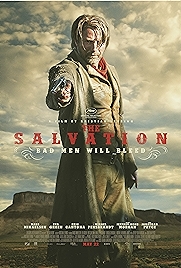Anyone for a Danish western, a great one? Made by one of the Dogme boys? If you look up Dogme in the Wikipedia, it will tell you that this particularly austere style (no music, no lights, no effects) was founded by two Danes, Von Trier and Vinterberg, who were soon joined by two others, Kragh-Jacobsen and Levring.
And it’s possible to read this film as an announcement, shout, by the least known of those directors, Kristian Levring, that he doesn’t do that Dogme thing any more. Because The Salvation contains every big movie trick in the book – a lush score, arresting sets, cinematography snatched at the golden hour, melodramatic camera movements, sudden close-ups, varying depth of focus, operatic composition, fabulous landscapes, digital backgrounds, post-production colour tweaks, heavy filtration… and on it goes.
If Dogme aimed for some sort of puritan truth and simplicity, Levring is now aiming at high artifice, maximum referentiality, the mega-meta. Every scene, every shot looks like it’s been borrowed from another film, another director – Sergio Leone’s theatrical scale (reinforced by Kasper Winding’s Morricone-esque soundtrack), John Ford’s monumental locations, Peckinpah’s slo-mo gunplay, Aldrich’s codes of masculinity and concern with ageing.
The same goes for the plot, which is a man’s-gotta-do revenger starring Mads Mikkelsen as a husband welcoming his Danish-speaking wife to the New World in the opening scene. Within minutes the thick-tongued locals are eyeing the wife (Nanna Øland Fabricius), and scant but brutally tense minutes after that Mikkelsen is a man with blood on his hands and a price on his head.
Perhaps it is Levring’s Dogme background – which relies heavily on performance, since there isn’t much else to fall back on – but there’s a just-rightness about the acting throughout, everyone seeming to get that this is homage not pastiche, a serious film not a joke. The always underrated and almost infinitely versatile Mikkelsen’s talents for scowling and suppressed rage are brilliantly deployed, but it’s around the edges that some of the most satisfying performances can be seen. Douglas Henshall (where has he been?) is particularly good as the shifty local sheriff who’s also a preacher, Jonathan Pryce also playing with a familiar type as the cowardly mayor who’s also the undertaker, everyone being in the pocket of local badman Jeffrey Dean Morgan, who periodically rides into town to menace the locals and kill someone because he doesn’t like the tilt of his hat.
This brings us to Eva Green, the wife of the man Mikkelsen has killed, and sister in law of Morgan, whose tongue has to be rolled back into his mouth so he can speak whenever she’s around. She, by contrast, has no tongue at all, it having been cut out by Injuns. The wordless Green, actress to the last, responds by using the equipment left in her armoury to deliver a role that proves you can wring more nuance than you might expect using flashing eyes and a heaving bosom.
These two wrong ’uns, with Mikkelsen skirting round the edge, will eventually meet up in the sort of ghost town that hasn’t been seen on film for decades, in the sort of big shoot-out that eclipses even the one in James Mangold’s 3:10 to Yuma.
Familiar people, familiar locations, familiar plotlines. If Jens Schlosser’s cinematography weren’t so jaw-dropping magnificent, if everything else weren’t so composed and primped and placed and sweated over, and if it weren’t so full of real stuf – dirt and sex and death – you’d be tempted to think someone was having a laugh. But Levring leaves one reveal for his final shot, which not only fully explains what’s been going on, but historically re-situates the entire film, you could say the entire genre. As the hero rides off into the sunset – hell yes – it’s a brilliant way to finish.
The Salvation – Watch it/buy it at Amazon
I am an Amazon affiliate
© Steve Morrissey 2014

